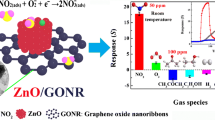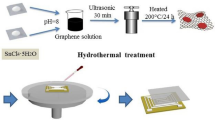Abstract
A hybrid material consisting of bulk-reduced TiO2, graphene oxide (GO) and polyaniline (PANI) was fabricated by decorating TiO2 with GO, followed by in-situ oxidative chemical polymerization of aniline. The TiO2 nanoparticles (NPs) with thermally stable bulk reduction states were initially prepared from porous amorphous titanium as the precursor. The TiO2 NPs and GO were chemically conjugated to each other via amide bonds to improve the stability of the composite. The sensor, if operated in the conductivity mode, exhibits strong signal changes, and fast response and recovery times (of 32 and 17 s, respectively) to gaseous ammonia even at room temperature. Its response range extends from 5 to 300 ppm, and the lower detection limit is 5 ppm. The sensor is fairly selective and not interfered by gases such as CO, CH4, and trimethylamine, and by vapors of methanol and ethanol. It also displays good temporal stability. This is attributed to the bulk-reduced state of TiO2, the presence of oxygen functional groups on GO, and the strong adsorption and rapid diffusion of ammonia. The results also imply the presence of a synergetic effect between TiO2 and GO/PANI, which is probably beneficial for the potential application of the resulting composite as a gas sensor.

A hybrid material consisting of bulk-reduced TiO2, graphene oxide (GO) and polyaniline (PANI) was fabricated by decorating TiO2 with GO, followed by in-situ oxidative chemical polymerization of aniline. The TiO2/GO/PANI sensor exhibits strong signal changes, fast response time (32 s) and recovery time (17 s) to ammonia at room temperature. It also displays good selectivity and temporal stability.






Similar content being viewed by others
References
Hu B, Chen W, Zhou J (2013) High performance flexible sensor based on inorganic nanomaterials. Sensors Actuators B: Chem 176:522–533
Comini E, Baratto C, Concina I, Faglia G, Falasconi M, Ferroni M, Galstyan V, Gobbi E, Ponzoni A, Vomiero A (2013) Metal oxide nanoscience and nanotechnology for chemical sensors. Sensors Actuators B: Chem 179:3–20
Bulakhe R, Patil S, Deshmukh P, Shinde N, Lokhande C (2013) Fabrication and performance of polypyrrole (Ppy)/TiO2 heterojunction for room temperature operated LPG sensor. Sensors Actuators B: Chem 181:417–423
Lin Q, Li Y, Yang M (2012) Tin oxide/graphene composite fabricated via a hydrothermal method for gas sensors working at room temperature. Sensors Actuators B: Chem 173:139–147
Lü R, Zhou W, Shi K, Yang Y, Wang L, Pan K, Tian C, Ren Z, Fu H (2013) Alumina decorated TiO2 nanotubes with ordered mesoporous walls as high sensitivity NOx gas sensors at room temperature. Nanoscale 5:8569–8576
Pawar S, Chougule M, Sen S, Patil V (2012) Development of nanostructured polyaniline-titanium dioxide gas sensors for ammonia recognition. J Appl Polym Sci 125:1418–1424
Lee JS, Ha TJ, Hong MH, Park CS, Park HH (2013) The effect of multiwalled carbon nanotube do** on the CO gas sensitivity of TiO2 xerogel composite film. Appl Surf Sci 269:125–128
Afzal A, Cioffi N, Sabbatini L, Torsi L (2012) NOx sensors based on semiconducting metal oxide nanostructures: progress and perspectives. Sensors Actuators B: Chem 171:25–42
**ong W, Liu HH, Liu ST (2015) Conductometric sensor for ammonia and ethanol using gold nanoparticle-doped mesoporous TiO2. Microchim Acta 182:2345–2352
Lira E, Wendt S, Huo P, Hansen JØ, Streber R, Porsgaard S, Wei Y, Bechstein R, Lægsgaard E, Besenbacher F (2011) The importance of bulk Ti3+ defects in the oxygen chemistry on titania surfaces. J Am Chem Soc 133:6529–6532
Fratoddi I, Venditti I, Cametti C, Russo MV (2015) Chemiresistive polyaniline-based gas sensors: A mini review. Sensors Actuators B: Chem 220:534–548
Dhawale D, Salunkhe R, Patil U, Gurav K, More A, Lokhande C (2008) Room temperature liquefied petroleum gas (LPG) sensor based on p-polyaniline/n-TiO2 heterojunction. Sensors Actuators B: Chem 134:988–992
**ang C, Jiang D, Zou Y, Chu H, Qiu S, Zhang H, Xu F, Sun L, Zheng L (2015) Ammonia sensor based on polypyrrole-graphene nanocomposite decorated with titania nanoparticles. Ceram Int 41:6432–6438
Ye Y, Wang P, Sun H, Tian Z, Liu J, Liang C (2015) Structural and electrochemical evaluation of a TiO2-graphene oxide based sandwich structure for lithium-ion battery anodes. RSC Adv 5:45038–45043
Singh G, Choudhary A, Haranath D, Joshi AG, Singh N, Singh S, Pasricha R (2012) ZnO decorated luminescent graphene as a potential gas sensor at room temperature. Carbon 50:385–394
Zhang Y, Xu J, **ang Q, Li H, Pan Q, Xu P (2009) Brush-like hierarchical ZnO nanostructures: synthesis, photoluminescence and gas sensor properties. J Phys Chem C 113:3430–3435
Chen F, Yan F, Chen Q, Wang Y, Han L, Chen Z, Fang S (2014) Fabrication of Fe3O4@ SiO2@ TiO2 nanoparticles supported by graphene oxide sheets for the repeated adsorption and photocatalytic degradation of rhodamine B under UV irradiation. Dalton Trans 43:13537–13544
Peng Y, Li J (2013) Ammonia adsorption on graphene and graphene oxide: a first-principles study. Front Environ Sci Eng 7:403–411
Wang M, Zhai S, Ye Z, He L, Peng D, Feng X, Yang Y, Fang S, Zhang H, Zhang Z (2015) An electrochemical aptasensor based on a TiO2/three-dimensional reduced graphene oxide/PPy nanocomposite for the sensitive detection of lysozyme. Dalton Trans 44:6473–6479
Hu T, Sun X, Sun H, Yu M, Lu F, Liu C, Lian J (2013) Flexible free-standing graphene-TiO2 hybrid paper for use as lithium ion battery anode materials. Carbon 51:322–326
Huang H, Gan M, Ma L, Yu L, Hu H, Yang F, Li Y, Ge C (2015) Fabrication of polyaniline/graphene/titania nanotube arrays nanocomposite and their application in supercapacitors. J Alloys Comp 630:214–221
Kim CH, Kim BH, Yang KS (2012) TiO2 nanoparticles loaded on graphene/carbon composite nanofibers by electrospinning for increased photocatalysis. Carbon 50:2472–2481
Zhang L, **a J, Zhao Q, Liu L, Zhang Z (2010) Functional graphene oxide as a nanocarrier for controlled loading and targeted delivery of mixed anticancer drugs. Small 6:537–544
Li J, Zhu L, Wu Y, Harima Y, Zhang A, Tang H (2006) Hybrid composites of conductive polyaniline and nanocrystalline titanium oxide prepared via self-assembling and graft polymerization. Polymer 47:7361–7367
**g L, Yang ZY, Zhao YF, Zhang YX, Guo X, Yan YM, Sun KN (2014) Ternary polyaniline-graphene-TiO2 hybrid with enhanced activity for visible-light photo-electrocatalytic water oxidation. J Mater Chem A 2:1068–1075
Zhang F, Cao H, Yue D, Zhang J, Qu M (2012) Enhanced Anode Performances of Polyaniline-TiO2-Reduced Graphene Oxide Nanocomposites for Lithium Ion Batteries. Inorg Chem 51:9544–9551
Tan S, Ji Y, Zhao Y, Zhao A, Wang B, Yang J, Hou J (2011) Molecular oxygen adsorption behaviors on the rutile TiO2 (110)-1 × 1 surface: an in situ study with low-temperature scanning tunneling microscopy. J Am Chem Soc 133:2002–2009
Ahn MW, Park KS, Heo JH, Park JG, Kim DW, Choi KJ, Lee JH, Hong SH (2008) Gas sensing properties of defect-controlled ZnO-nanowire gas sensor. Appl Phys Lett 93:263103
Prezioso S, Perrozzi F, Giancaterini L, Cantalini C, Treossi E, Palermo V, Nardone M, Sandro S, Ottaviano L (2013) Graphene oxide as a practical solution to high sensitivity gas sensing. J Phys Chem C 117:10683–10690
Yavari F, Chen ZP, Thomas AV, Ren WC, Cheng HM, Koratkar N (2011) High sensitivity gas detection using a macroscopic three dimensional graphene foam network. Sci Rep 1:166
Lupan O, Ursaki VV, Chai G, Chow L, Emelchenko GA, Tiginyanu IM, Gruzintsev AN, Redkin AN (2010) Selective hydrogen gas nanosensor using individual ZnO nanowire with fast response at room temperature. Sensors Actuators B: Chem 144:56–66
Xu H, Chen X, Zhang J, Wang J, Cao B, Cui D (2013) NO2 gas sensing with SnO2-ZnO/PANI composite thick film fabricated from porous nanosolid. Sensors Actuators B: Chem 176:166–173
Deshpande N, Gudage Y, Sharma R, Vyas J, Kim J, Lee Y (2009) Studies on tin oxide-intercalated polyaniline nanocomposite for ammonia gas sensing applications. Sensors Actuators B: Chem 138:76–84
Tai H, Jiang Y, **e G, Yu J, Chen X (2007) Fabrication and gas sensitivity of polyaniline-titanium dioxide nanocomposite thin film. Sensors Actuators B: Chem 125:644–650
Acknowledgments
This work was supported by Program for the National Natural Science Foundation of China (NSFC: Account No. 51173172), Science and Technology Opening Cooperation Project of Henan Province (Account No. 132106000076) and the Key Project of Science and Technology of Education Department of Henan Province (Account No. 14 A150003).
Author information
Authors and Affiliations
Corresponding authors
Ethics declarations
The author(s) declare that theyhave no competing interests.
Electronic Supplementary Material
ESM 1
(DOC 459 kb)
Rights and permissions
About this article
Cite this article
Tian, J., Yang, G., Jiang, D. et al. A hybrid material consisting of bulk-reduced TiO2, graphene oxide and polyaniline for resistance based sensing of gaseous ammonia at room temperature. Microchim Acta 183, 2871–2878 (2016). https://doi.org/10.1007/s00604-016-1912-6
Received:
Accepted:
Published:
Issue Date:
DOI: https://doi.org/10.1007/s00604-016-1912-6




